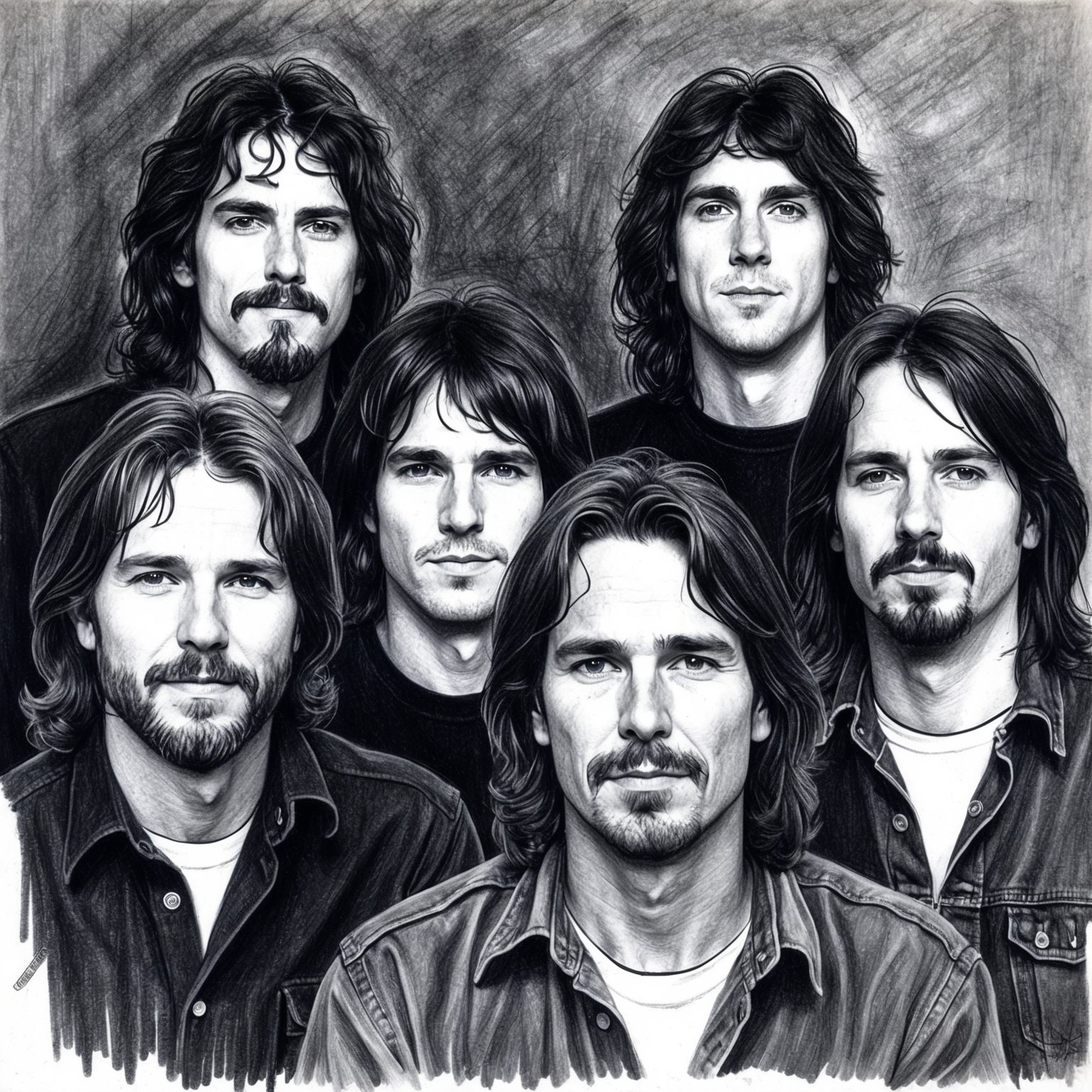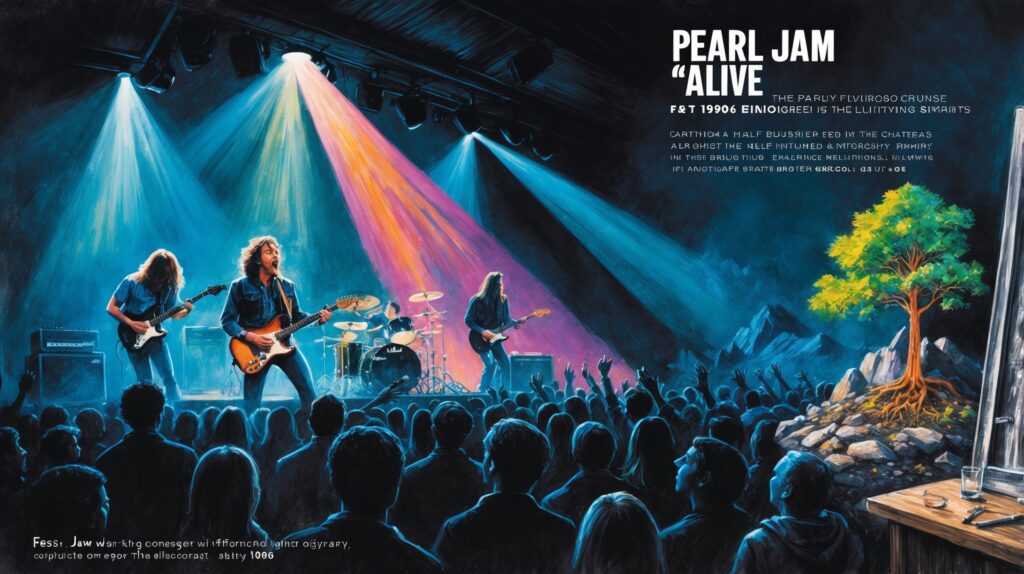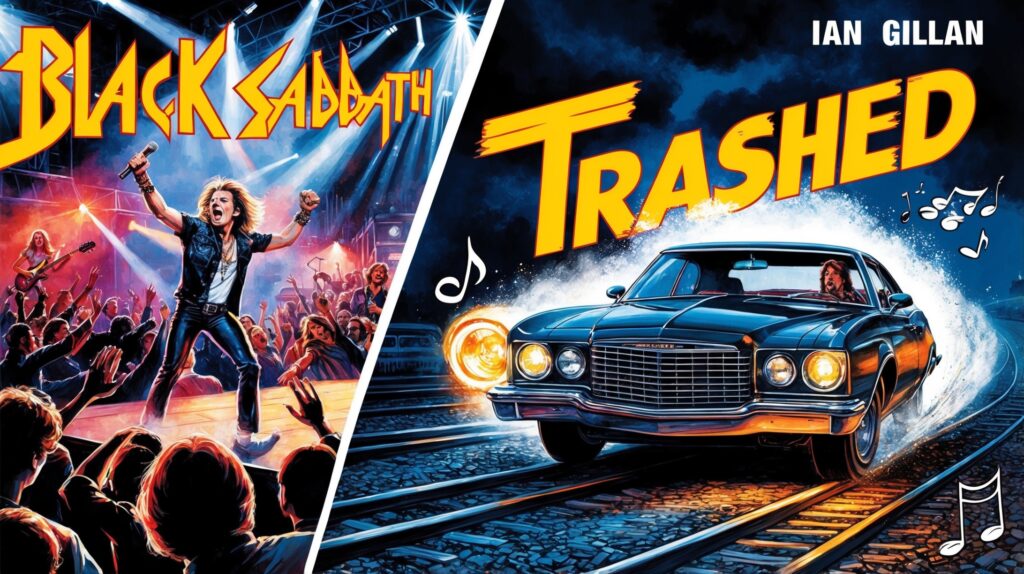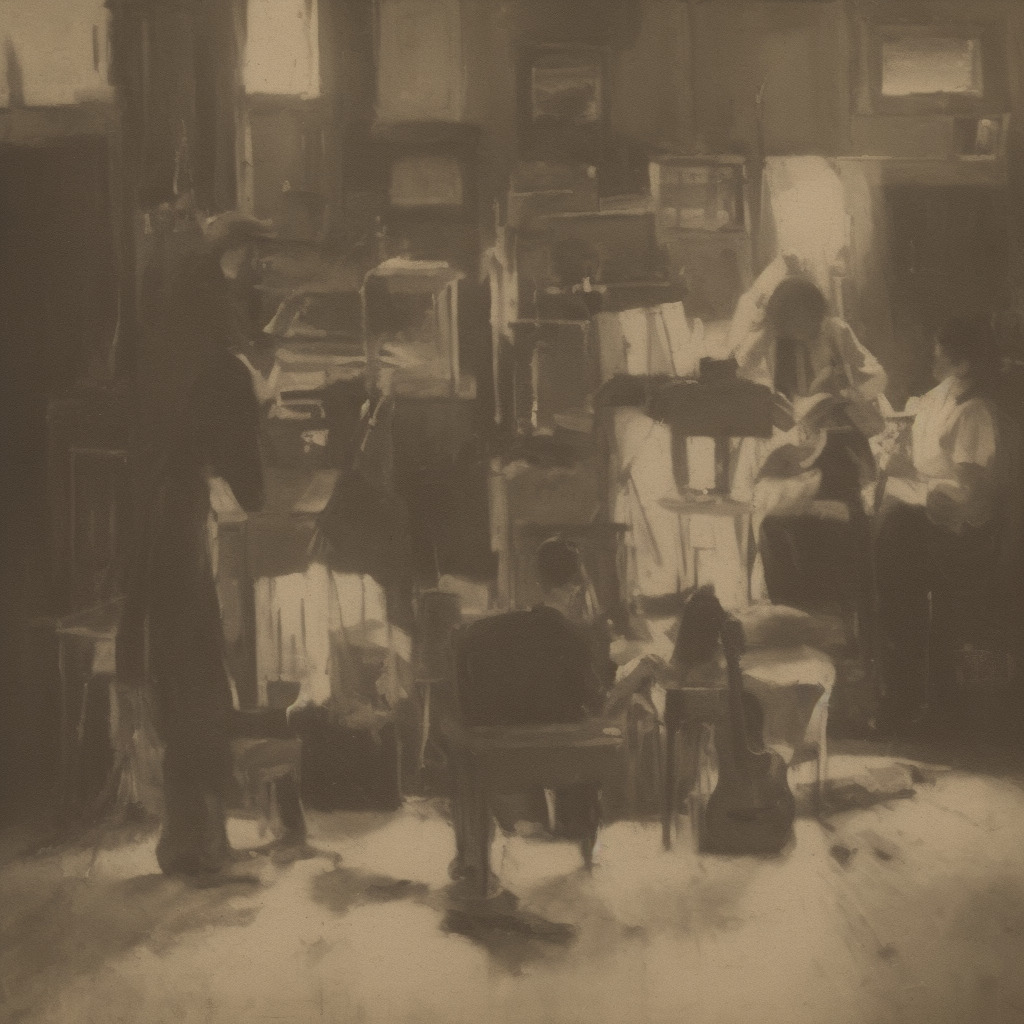Pearl Jam: A Band That Defined an Era
Pearl Jam broke through in the early 1990s with their iconic song ‘Alive’, leaving a lasting legacy in rock history. Formed in Seattle, the band captured the spirit of the grunge era, spearheaded by Eddie Vedder’s evocative voice and the band’s distinct sound.

Pearl Jam is a name that stands out in the annals of rock history, primarily due to their significant impact on the grunge music movement of the early 1990s. The band was formed in Seattle in 1990 and quickly rose to prominence with their debut album, ‘Ten’. Among its powerful tracks is ‘Alive’, a song that gave the band its initial fame and resonated deeply with audiences. ‘Alive’ is more than just a song; it’s a testament to the band’s raw energy and the emotional intensity that characterizes their music. Together, Pearl Jam’s members – Eddie Vedder, Jeff Ament, Stone Gossard, Mike McCready, and initially Dave Krusen – carved out a distinctive niche within the music industry, with ‘Alive’ playing a pivotal role in their journey.
The roots of Pearl Jam’s storied career trace back to the bustling Seattle music scene. Their unique blend of rock, punk, and alternative sounds positioned them perfectly in the zeitgeist of the 90s. Before the formation of Pearl Jam, its members had already been deeply involved in the local music scene, performing in various bands like Mother Love Bone and Temple of the Dog. Eddie Vedder, who was recruited through a demo tape exchange, brought a compelling voice and extraordinary lyrical depth to the lineup, shaping ‘Alive’ into a song that tells a deeply personal story layered with universal themes.
‘Alive’ marked a significant moment in Pearl Jam’s early career, being one of the first songs they wrote together, showcasing their incredible synergy. Released during a time when grunge was becoming the new face of rock, the song mirrored the emotional unrest and disillusionment of the youth. Its raw and introspective lyrics combined with a powerful guitar riff made it an instant classic. The band quickly became known for their energetic live performances and ‘Alive’ often served as a highlight, embodying the spirit and angst of a generation eager for change.
Behind the Melody: Exploring the Composer of ‘Alive’
Delve into the musical genius of Stone Gossard, the composer behind Pearl Jam’s iconic track ‘Alive’. Discover his journey, influences, and pivotal role in shaping the song that marked a defining moment in alternative rock.

At the heart of Pearl Jam’s profound and powerful track ‘Alive’ lies the remarkable compositional work of Stone Gossard, a musician whose contributions have been pivotal in shaping the sound of alternative rock. Gossard, a co-founder of Pearl Jam, has been a driving force in crafting the band’s signature sonic landscape. His journey into music began in his hometown of Seattle, where the burgeoning grunge scene offered fertile ground for his creative explorations.
Stone Gossard’s musical style is characterized by his versatile guitar playing and an intuitive sense of rhythm and melody. Drawing influences from classic rock, punk, and heavy metal, Gossard has managed to synthesize these elements into a distinctive sound that resonates with fans across genres. His early work with bands like Green River and Mother Love Bone laid the groundwork for the grunge movement, honing his skills and carving out his musical identity.
When it came to ‘Alive,’ Gossard’s role was crucial in its creation. His guitar riffs form the backbone of the track, providing a dynamic and anthemic foundation that complements Eddie Vedder’s evocative lyrics. Gossard’s skillful interplay between rhythm and lead guitar parts adds depth and intensity to the song, showcasing his ability to blend musical complexity with raw emotion. His composition for ‘Alive’ not only contributed to the song’s success but also encapsulated the essence of Pearl Jam’s sound during its formative years.
A Testament to ‘Alive’: Covers, Awards, and Cultural Impact
Alive’ by Pearl Jam, though lacking official awards, has achieved landmark status through its cultural impact, notable covers, and presence in various media. Its power resonates through live performances, films, and video games, cementing its legacy.

‘Alive’ by Pearl Jam is not just a song; it’s an enduring anthem that has resonated with generations of rock enthusiasts. Over the years, the track has received several accolades and has been celebrated in different forms of media, highlighting its significant impact on the music landscape. While ‘Alive’ did not win any notable awards, it is revered by the music industry and fans alike as a timeless classic. The song’s iconic status stems from its profound influence rather than from traditional accolades.
Being such a powerful and evocative piece, ‘Alive’ has been covered by various artists over the years. Notably, the Foo Fighters have performed this song during live shows, adding their unique spin while maintaining the core emotional intensity that characterizes the original. Furthermore, the song’s universal theme of resilience and struggle makes it a popular choice among rock bands worldwide.
‘Alive’ has also appeared in several cultural mediums, reinforcing its evergreen nature. It has featured in beloved movies like ’50/50′ starring Joseph Gordon-Levitt, and its energetic riffs and powerful vocals have made it a favorite in television soundtracks and video game music, including a memorable presence in the ‘Rock Band’ series. The song’s presence across various platforms shows that while it may not have gathered many formal awards, its accolades lie in its ability to continue inspiring and energizing fans across different formats and generations.
Rising to Prominence: Unpacking ‘Alive’ on the Charts and Its Cultural Echo
Alive’ by Pearl Jam marked a noteworthy rise on music charts globally, establishing their presence in the grunge scene. Aided by tactical marketing efforts, the song achieved lasting recognition and left a cultural imprint that resonates in today’s music landscape.

‘Alive’ by Pearl Jam, released as their debut single in 1991, marked a significant entry into the music charts, symbolizing the band’s official entry into the industry spotlight. Starting modestly, the song’s initial chart position did not attain immediate top-tier status. However, its growing popularity soon saw it peak at an impressive 16 on the US Mainstream Rock Tracks chart, illustrating its robust appeal amid an era teeming with musical innovation. Interestingly, in the UK, ‘Alive’ reached an even loftier status, ascending to number 16 on the UK Singles Chart, showcasing its international resonance.
Compared to other tracks released during the grunge movement of the late 1980s and early 1990s, ‘Alive’ held its own amidst looming titans. While other contemporaries like Nirvana with their breakthrough hit ‘Smells Like Teen Spirit’ were climbing charts worldwide, ‘Alive’ significantly contributed to solidifying Pearl Jam’s position in the grunge pantheon. Its success helped Pearl Jam secure a steady foothold in the music industry, serving as a resounding initial step in a career replete with iconic tracks and albums.
The song’s chart impact speaks to the meticulous marketing strategies employed by Pearl Jam’s label, Epic Records. Through engaging live performances, strategic inclusion in playlists, and stirring visuals from its music video, ‘Alive’ was effectively elevated from a grunge anthem to a timeless rock classic. Despite the absence of conventional digital marketing tools like TikTok, ‘Alive’ harnessed the power of MTV and other platforms of the time, ensuring it snagged the attention of both critics and fans alike. Its legacy is deeply woven into the tapestry of rock music, inspiring countless artists and cementing itself as an emblematic track of a generation.
The Untold Story Behind Pearl Jam’s ‘Alive’ Live Performances
Although ‘Alive’ by Pearl Jam lacks an official music video, its powerful live performances and fan-made videos act as its visual counterpart, adding to its legendary status.

The song ‘Alive’ by Pearl Jam, seminal in the landscape of modern rock, lacks an official music video but is brought to life through a plethora of live performances and fan-made videos that capture its explosive essence. These live performances are far from just concerts; they are a crucial extension of the song’s aura, encapsulating the raw energy and emotional weight of the track. With electrifying displays from frontman Eddie Vedder and the band, these renditions often transcend the essence of a traditional music video, offering fans an unfiltered glimpse into what makes ‘Alive’ a timeless anthem.
The lack of an official music video hasn’t hindered the song’s popularity, thanks largely to the numerous fan-created videos and visual interpretations available online. These videos, often blending concert footage, interviews, and behind-the-scenes snippets, manage to capture the song’s emotional depth, making it relatable across generations. These projects reflect the community Pearl Jam has built around their music, each one reminding viewers why ‘Alive’ continues to resonate globally even decades after its release.
As the song grew into a concert staple, its live performances gained attention from critics and fans alike, who appreciated the intense and heartfelt delivery of the group. With Eddie Vedder’s hauntingly powerful voice and the band’s vibrant instrumentals, ‘Alive’ live versions have garnered immense popularity. The interplay among the band members amplifies the song’s emotional core, proving that even without a traditional music video, Pearl Jam’s message remains unmistakably powerful.
Exploring the Intricate Soundscape of ‘Alive’
Discover the intricate musical structure of Pearl Jam’s ‘Alive,’ from its key and tempo to the evocative interplay of instruments. Learn how this iconic track fits within the band’s discography.

‘Alive’ by Pearl Jam is a masterclass in rock music composition, blending emotive storytelling with a powerful musical structure that leaves an indelible impact. The song is predominantly written in the key of A major, which serves to amplify its uplifting yet poignant tonality. It follows a classic verse-chorus form, interspersed with a bridge that enhances its thematic narrative.
The tempo of ‘Alive’ is approximately 76 beats per minute, a moderate pace that allows the song to build tension and release in equal measure. This tempo supports the dynamic shifts between verses and the anthemic chorus, creating a rhythmic ebb and flow that mirrors the lyrical journey of self-discovery and resilience.
The harmonic foundation of the song is laid out with a distinctive chord progression that underscores the emotion within the lyrics. The melody is characterized by its gritty yet melodic vocal delivery, which Eddie Vedder performs with raw intensity. The interplay of guitars, propelled by Stone Gossard and Mike McCready, crafts a rich tapestry of sound, with McCready’s iconic guitar solo acting as the song’s emotional peak.
The rhythm section, driven by bassist Jeff Ament and drummer Dave Krusen, anchors the song with its steady yet propulsive groove. This solid rhythmic backdrop serves as a canvas for the expressive lead guitar work and vocals, creating a cohesive and immersive musical experience.
Placed within Pearl Jam’s discography, ‘Alive’ exemplifies the raw energy and authenticity of their early work, setting the stage for their subsequent evolution. Compared to later albums, this song captures the band’s nascent grunge sensibilities, highlighting their potential for emotive expression and complex musical arrangements, all hallmarks that would define their career.
Exploring Themes, Narratives, and Emotional Depth in ‘Alive’
Delve into the evocative lyrics of Pearl Jam’s ‘Alive’, a song that weaves themes of identity and existential resilience through its intimate narrative.
“Have I got a little story for you?”
“What you thought was your daddy
Was nothin’ but a-”
“While you were sittin’
Home alone at age 13
Your real daddy was dyin’
Sorry you didn’t see him
But I’m glad we talked”
Oh I, oh, I’m still alive
Yeah, yeah, I, oh, I’m still alive
Yeah, yeah, I, oh, I’m still alive, yeah, oh
While she walks slowly
…
******* This Lyrics is NOT for Commercial use *******

Pearl Jam’s ‘Alive’ is a deeply evocative track that resonates with audiences through its compelling narrative and raw emotional intensity. At its core, the song dives into profound themes of identity, existential continuity, and survival. Frontman Eddie Vedder’s haunting lyrics unfold a story that touches on personal and familial revelations, offering listeners a glimpse into a moment of truth and self-discovery. The themes wrapped within this powerful anthem are both personal and universal, resonating with individuals who have experienced moments of truth and revelation in their own lives.
The narrative of ‘Alive’ is notably intimate and confessional, told from a first-person perspective that adds to its emotional weight. The story revolves around a shocking revelation where the protagonist learns that his assumed father is not biologically related, and that his real father had passed away. This abrupt confrontation with truth challenges the listener to reflect on their own understanding of life and identity. Vedder’s narrative technique provides a stark, unfiltered window into this personal turmoil, inviting empathy and introspection from the audience.
Literary devices play a crucial role in enhancing the song’s impact. The use of direct dialogue, as in the opening lines, ‘Son,’ she said, ‘Have I got a little story for you?’ establishes an immediate intimacy and grounding in the narrative. Vedder’s word choices are simple yet piercing, allowing the emotional core of the lyrics to resonate powerfully. Metaphors and allusions subtly weave through the song, adding layers of meaning. For example, the repeated refrain ‘I’m still alive’ is both a statement of resilience and an existential reflection, capturing a spectrum of emotions from defiance to despair.
In comparison to other works by Pearl Jam, ‘Alive’ stands out for its confessional intensity and cathartic release. While songs like ‘Black’ and ‘Jeremy’ explore similarly complex emotional landscapes, ‘Alive’ is unique in its blend of personal storytelling and broader existential themes. This song paved the way for grunge’s musical narrative style, aligning with the raw authenticity and introspection that the genre is celebrated for. The broader cultural and social context of the 1990s also plays into its resonance; at a time when audiences were longing for genuine expression and challenging established norms, Pearl Jam offered a voice that was both rebellious and introspective.
? Did you know? Pearl Jam’s Alive almost didn’t have Eddie Vedder! He joined the band after sending lyrics via cassette tape. Talk about destiny! #PearlJam #RockHistory #GrungeLegend ?? https://bit.ly/4eXSgrI
Click to Tweet







